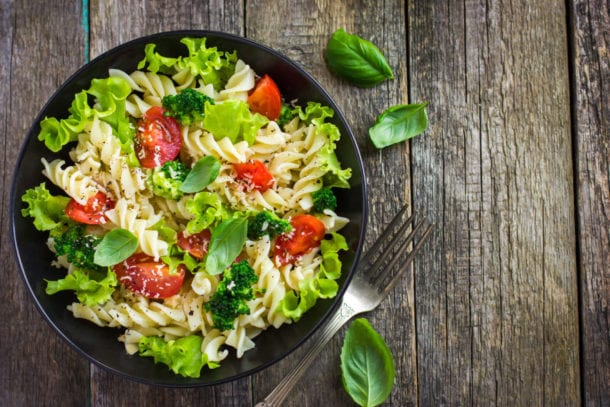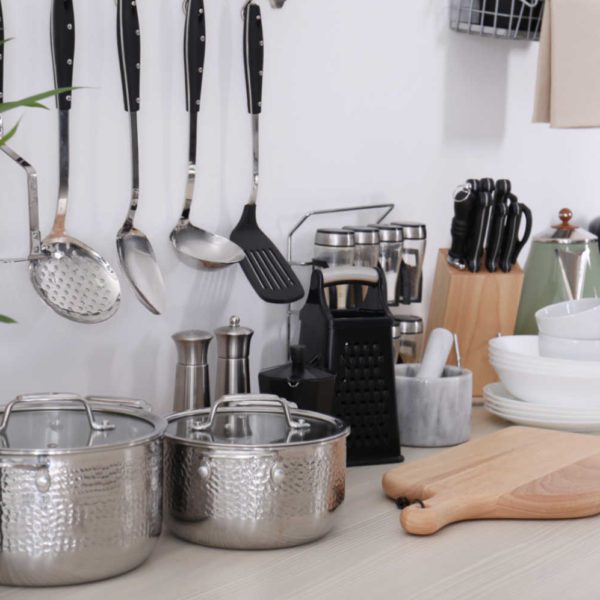Are you intrigued by the idea of your own chef’s knife, but are unsure where to start or how to decide which is best? Are you overwhelmed with the number of chef’s knife choices? Do you find yourself choosing a knife based on how it looks or if it’s on sale, only to find it doesn’t hold up or stay sharp? Do you love the aesthetics of hand-crafted Japanese knives but are overwhelmed by the choices?
I know where you’re coming from. The vast array of options and technical mumbo jumbo tossed around by knife experts can be bewildering. Stores have a baffling number of choices.
“I like the Japanese knives, I like French knives. Whatever’s sharp.” – Wolfgang Puck
How do you choose the right chef’s knife?
Read on, my friend.

My obsession with knives started in the boy scouts when my father gave me a chunky folding Buck knife in a leather holster. That thing could open cans and whittle a totem pole. Fast forward to my culinary classes in college and I knew I needed the perfect kitchen knife like my chef heroes Masaharu Morimoto and Alex Guarnaschelli. Endless research and experimentation ensued.
Let me break it down for you and make it simple. Here are the four things to consider when selecting the most important tool in your kitchen.
Read to the end to find out where I landed.
1. Type of Steel
Most kitchen knives are made of stainless steel. Stainless steel is a composite of iron alloys that, relevant to kitchen knives, contains carbon, among other ingredients. Why does this matter, you ask. Because the percentage of carbon in the blade determines its relative hardness and brittleness. As a general rule, Japanese knives have more carbon than their German counterparts. This allows a Japanese blade to stay sharper longer.
Great, you say. I’ll get a Japanese knife.
Not so fast. The extra carbon also makes the blade more brittle.

Hardness is measured by the Rockwell scale. It measures hardness based on the depth of penetration of a diamond cone pressed into the material at a constant pressure. For example, Wüsthof knives clock in at a 58 on the Rockwell scale. Shun knives range in hardness between 60-62. The higher the number, the harder the steel. The higher the number, the more brittle the steel.
As a result, Wüsthof kitchen knives are generally softer and easier to sharpen. Shun knives are harder, more brittle, and hold an edge longer. See the tradeoff? Would you rather your knife stay sharper longer, but be more difficult to sharpen? Or require more sharpening, and be easier to sharpen? Or would you rather your knife be sharper and more brittle?
Your choice, dear reader. It’s your chef’s knife.
This tradeoff between harder and softer steel has other considerations. Japanese knives are thinner, lighter, and more suited to slicing forward and backward, where German knives are thicker, heavier, and better for chopping. Japanese knives are more nimble and less fatiguing. German knives are hardier. Chop open an acorn squash with a Wüsthof. Butterfly your portobello with a Shun, but don’t try to cut a frozen banana with it for your overnight oats.
2. Bevel, or Blade Angle
The bevel is the angle at which the blade is, well, a blade. That is, the angle of the edge. The percentage of the point. Well, the blade, not the point. But you get the point….
Okay, now you’re getting deep. Do I really need to know this?
Yes! Hear me out.
Historically, German knife bevels tended to be shallower than their Japanese counterparts; around 20 degrees. There is a trend to narrower bevels. Wüsthof and Zwilling are making knives at 14 percent and 15 percent respectively. Japanese knife makers sharpen to a 15 to 17-degree bevel.

What’s better? I’m glad you asked. Similar to steel hardness, it depends. When combined with the more brittle steel and thinner blade of Japanese knives, a narrow bevel is precise and cuts with less friction, but is prone to damage. This is partly why the blade on Jill’s Shun Premier is nicked and dinged. It doesn’t help that we didn’t know this when we bought the Shun.
Although German knives have similarly angled bevels as their Japanese competitors, German blades tend to be thicker and made from more forgiving steel. German blades are less precise – you won’t see anyone preparing sushi with one – but they hold up better over time.
Why bevel matters on a chef’s knife
A kitchen knife is a long-term investment. Unless you want to buy a new one every time your knife gets too dull to saw through a tomato, you’re going to learn to hone and sharpen your knives. To ensure you sharpen your knife correctly, you need to know the bevel angle and whether your blade has a single or double bevel.
For example, take these two knife sharpeners from Chef’s Choice.
Both sharpeners are about the same price. The main difference is that the Trizor XV sharpens at a 15-degree angle whereas the 325 sharpens to a 20-degree angle. I was sharpening a 14-degree Wusthof with a 20-degree sharpener for years without knowing. It’s not the end of the world, but I lost an opportunity to maximize the utility of the knife.
If you’re looking for a 14-degree electric sharpener for your Wüsthofs, try this one from Chef’s Choice.
For more on sharpening your knives, check out our post on How to Care For Your Chef’s Knife.
Double Bevel versus Single Bevel
Most modern knives are double bevel. In other words, two angles form the edge on the steel blade. Some knives, primarily nichey Japanese models, are made with a single bevel; that is one angle forms the point. What’s the point? Single bevel knives hold their edge longer and are helpful for precision work like slicing a piece of Bluefin tuna for your nigiri.
Know the bevel angle and style of your knife to enable proper sharpening technique.
3. Balance, Aesthetics, and Style
Maybe the most important factor in your decision is how the knife feels in your hand. If you like the feel and are comfortable with the blade, you’re more likely to use the knife and take care of it. Japanese knives tend to be more balanced – that is you can position the blade near the handle on your finger and it will balance. This is because most Japanese knives typically dispense with the bolster, which is the bits of shaped metal between the blade and the handle. Of course, the bolster can be an important safety feature or provide a more comfortable grip.
What is your cutting style?
Pay attention to the shape of the blade. German chef’s knives are more rounded and suitable for rocking and chopping, where Japanese knives tend to be straighter and work better for slicing and intricate cutting.
Aesthetics
Does the handle feel grippy or will it be slippery when wet? Prefer the more classic look of faux wood or a more streamlined plastic composite handle? Do you like the dimples some knives use to allow food to slip off? Or do you like the classic style of pure steel? Do you enjoy using it? Will you protect the knife and care for it like it’s a loved pet?
If you can, visit a store and take a few different knives for a spin before you buy. Or order three, try them out, and return the two you like the least.
Enough Blather, Which Chef’s Knife Do You Recommend?
You have to decide for yourself, but I will tell you what we use:
Wüsthof 6 inch chef’s knife Classic

Don’t get me wrong. I love a beautifully crafted and aesthetically attractive Japanese cutting instrument. But our kitchen can’t handle it. We’re banging out recipes and meals and we chop the heck out of our vegetables. Jill is hacking up a pineapple after I thwack open a watermelon. The knife gets tossed in the sink, dropped on the floor, and flung aside. Jill probably uses it to open tofu packages while I’m not looking. I’d love to pretend that Jill and I are masterfully preparing our dishes in hues of grays and taupes while listening to Ahmad Jamal. The reality is we’re more rock ‘n roll than Mozart.
We need a workhorse knife. One that can take a beating and still chop a tomato. And for that reason, we choose Wüsthof. After we learned the hard way that the Shun Premier wouldn’t hold up in our kitchen, we got Jill the 6-inch version of the Wüsthof chef’s knife with the classic handle. She loves it.
My 8-inch Wüsthof chef’s knife has lasted me since before Jill and I were a thing. My Wüsthof paring knife was a best man’s gift from a wedding back in the ’80s. if you take care of them, your Wusthof’s will last longer than you will. And for that reason, we chose Wüsthofs.
Products Mentioned in This Post:
Wüsthof 6-Inch Chef’s Knife
Shun Premier 6-Inch Chef’s Knife
Wusthof 8-Inch Chef’s Knife
Chef’sChoice Trizor XV EdgeSelect
Chef’sChoice 325 Professional Diamond Hone Sharp-N-Hone
What’s Next?
Drop me a comment below and let me know what I missed. What chef’s knife do you use, and why? What matters to you about knives?
Once you have procured your knife, please read this post on How to Care For a Chef’s Knife.



Leave a Reply